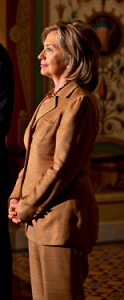The Fashion Conservatives
October 22, 2010
By Ruth LaFerla, New York Times
 A WOMAN seeking political office in 2010 faces a fashion quandary. The choice, in simplest terms, comes down to this: to follow the lead of Sarah Palin or cast a style vote with Hillary Rodham Clinton.
A WOMAN seeking political office in 2010 faces a fashion quandary. The choice, in simplest terms, comes down to this: to follow the lead of Sarah Palin or cast a style vote with Hillary Rodham Clinton.
At a glance, Ms. Palin — she of the designer jackets, rump-hugging skirts and knee-high boots — would seem to have been a game changer, loosening up a restrictive, if unwritten, campaign dress code with one that expresses a more conventionally feminine look. Her bright, curve-enhancing garments and loose, shoulder-grazing hair — even her rimless glasses — have been taken up by a handful of candidates on the climb. This is especially true of fellow Republicans like Nikki Haley of South Carolina, Christine O’Donnell of Delaware and Representative Michele Bachmann of Minnesota, who appear to be following Ms. Palin’s style cues with striking fidelity.
Lisa A. Kline, the image consultant behind Ms. Palin’s controversial $150,000-plus fashion makeover during the 2008 campaign, views her client’s embrace of an overtly female archetype as a signal of rebellion. “Women want to change their image.” Ms. Kline said in an interview. “They had been in the mimicking-men phase for so long. Now they are going for femininity.
Well, look again, Ms. Kline. For all the ridicule that Mrs. Clinton’s boxy pantsuits have generated over the years — she seems to own one in every color, like turquoise and fuchsia — her mannishly functional wardrobe remains the go-to choice for women on the path to power.
On their own steam — or perhaps at the suggestion of a battery of campaign advisers — the majority of candidates are retreating, as they have for decades, to the relative safety of an anodyne uniform. Understated to a fault, its chief components are a formless suit, flat or low-heeled shoes and a noncommittal hairstyle. It’s a brusquely masculine image tempered occasionally by a strand of pearls and dainty, never dangly, earrings (the latter deemed too distracting for television cameras).
“A Palin effect? Show it to me,” said Christine K. Jahnke, a media trainer who advised Mrs. Clinton during her presidential campaign. “Women aren’t trying to look like Sarah Palin. That would be a mistake.”
They are for the most part “still walking a tightrope,” said Ms. Jahnke, who advises female candidates to adopt a high-quality, low-key wardrobe befitting a corporate chief executive. “You have to look approachable and, at the same time, look like you can handle the job,” she said.
Siobhan Bennett, president of the Women’s Campaign Forum, a bipartisan group that seeks to get women elected, sees plenty of Americans adopting Ms. Palin’s glasses and “bedhead” coif. “But that’s in the general populace,” Ms. Bennett stressed, “not on the campaign trail.”
Indeed, there is much to suggest that women who aspire to office continue to dress defensively. Frightened, even terrified, of committing a wardrobe gaffe on national airwaves, most adhere to a rigid, patently dated style that has all the allure of a milk carton.
The prevailing look, modeled on corporate executives, with an occasional nod to the astringent style of female news anchors, is anathema to professional style-watchers. When, during her presidential campaign, Mrs. Clinton declined an invitation to appear in Vogue magazine for fear, her handlers said, of appearing “too feminine,” Anna Wintour fired off a scathing editor’s letter.
“The notion that a contemporary woman must look mannish in order to be taken seriously is frankly dismaying,” Ms. Wintour chided. “I do think Americans have moved on from the power suit mentality. Political campaigns that do not recognize this are making a serious misjudgment.”
To read the full story, click here.

